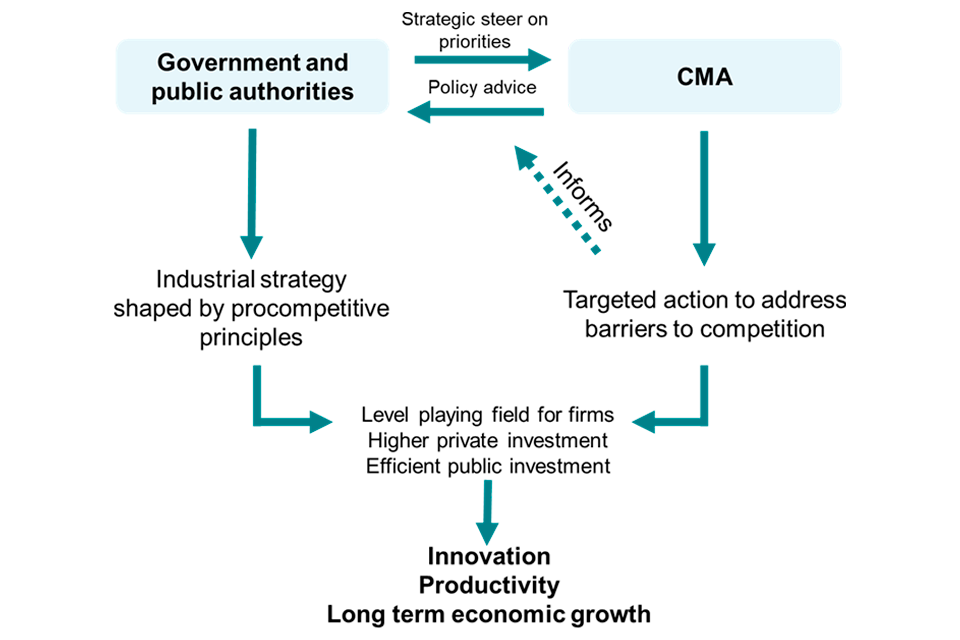Industrial Strategy Green Paper: summary
Published 21 November 2024
Introduction
Our response to the Green Paper is under-scored by our commitment to working with government on an industrial strategy that achieves the most productive and sustainable growth across the UK economy. We will support the industrial strategy by:
-
providing advice to government on how it can harness the power of competitive rivalry to maximise the long-term impact and value of its industrial strategy across the whole UK economy
-
using our powers directly to promote growth, including through market studies and investigations, enforcement against illegal anticompetitive conduct and breaches of consumer protection law, and our approach to mergers
Effective competition is a proven route to a higher growth economy. Evidence and history show us that where competition is stronger, innovation productivity and wage growth will be higher. We have also seen firsthand through our case work that competition and contestability are catalysts for innovation and promoting an entrepreneurial environment – which is at the heart of growth for any modern economy.
Successful long-term industrial strategy should have competition policy at its core. Just as skills, trade, tax or energy policy are key levers to support sectoral growth, so too is competition policy.
This document summarises the CMA’s views on industrial strategy, as set out in our full response to the government’s Green Paper. It focusses on driving investment, the role of the CMA, the sectoral focus of the industrial strategy and creating a pro-business environment.
Driving investment
A dynamic economy, which rewards innovation and productivity, is a magnet for entrepreneurs with a keen eye for opportunities to found and grow businesses, and for the investors and capital which back them. When competing on a level playing field, firms are spurred on to invest so that they can out-perform their rivals. Where markets are not contestable, incumbents are safe from challenge, and everyone’s incentives are reduced. Incumbents worry less about losing their position, so invest less to improve their offer. Firms and entrepreneurs will not invest to enter new markets with innovative new products, if they don’t have a fair chance of success.
The government’s focus on increasing investment to drive economic growth is well founded. Evidence shows that the most important contributor to the UK’s recent low productivity growth relative to other countries is weaker investment.
Competition is a critical requirement, but not sufficient on its own; investment ultimately depends upon a broad set of conditions. This is reinforced through our engagement with business and investors, who describe cross-economy and sector specific barriers to investment. To make investments, businesses need not only a level playing field, but access to workers with the right skills and quality infrastructure. They need a degree of policy certainty, so they can plan ahead. They also need clear and proportionate regulation. Competitive rivalry alone cannot overcome barriers such as skills shortages or planning delays. But when coupled with the wider set of conditions, competition works to ensure that higher investment leads to long-term growth.
In some markets, weak competition is the major barrier to investment and needs to be addressed. Levelling the playing field for all firms can make a major contribution. We have seen in practice the transformative effect of competition, including in the fintech sector following the introduction of Open Banking, or through actions to promote competition in the airport sector, which resulted in a more dynamic and innovative market.

Example of tackling barriers to competition: Open Banking
The banking sector had long-standing barriers to competition. The CMA found that older and larger banks did not have to compete hard enough for customers’ business, and smaller and newer banks found it difficult to grow.
Open Banking was central to the package of reforms introduced by the CMA to address these issues. Open Banking has since become a major success, spurring data-driven innovation, investment and growth in financial services, contributing to the growth of the UK’s fintech sector, both domestically and internationally.
The CMA plays a key proactive role in providing an environment which encourages investment. We work to promote investor confidence in the UK, including as the UK’s merger review body, through proportionate, evidence-based decision making, and through engagement and dialogue so we can understand, and address, concerns where they arise.
The CMA’s role in the industrial strategy
The CMA contributes to the industrial strategy in 2 broad ways:
-
we will provide advice to government and public authorities, to help ensure that policies, investment support, and procurement harness the power of competition
-
we will use our powers directly to promote open, competitive markets, to drive innovation, productivity and investment and therefore long-term economic growth

Diagram showing collaboration between CMA, government and public authorities, demonstrating how their joint work leads to innovation, productivity and long-term economic growth.
As an adviser to government, we support the integration of pro-competitive principles into the industrial strategy. Through a pro-competitive industrial strategy government can:
-
design policies to maximise the ability and incentives for firms to compete
-
use competitive processes to drive efficiency and value in the use of public resources, including through procurement
-
better target interventions to promote competition to unlock productivity and growth, such as through measures focused on smaller and younger firms

Example of CMA advice to government: electric vehicle charging
The CMA completed a market study in 2021 into electric vehicle charging. We made 8 recommendations to promote competition so as to unlock investment in this key market. This included recommending to government that subsidies to help the market grow should be used to open up competition, through requiring interoperability across electric vehicles. This went beyond traditional approaches of minimising distortions to competition, and instead saw subsidy design as a potential pro-active tool to make investments pro-competitive.
We can also play a direct role in supporting the industrial strategy through targeted action to address barriers to competition using our competition and consumer protection powers:
-
we carry out in-depth reviews when particular markets are not working well, to open up opportunities for innovation and growth
-
we tackle illegal practices that undermine competition, empowering fair-dealing businesses to compete and grow
-
we enforce consumer protection law, so that consumers can engage confidently in markets, spurring innovation and growth
-
we perform the UK’s merger control function in a highly targeted way, enabling the vast majority of mergers and acquisitions to go ahead, whilst looking more closely at the small number of cases which present a risk for competition and growth

Example of direct CMA action to address barriers to competition in construction
Construction is a critical sector on which almost every other part of our economy depends. Tackling illegal anticompetitive practices in the construction sector has been a priority for the CMA in recent years. For example, the CMA fined 3 suppliers of essential concrete products for roads and railways and large infrastructure projects for participating in a secret cartel, which fixed prices and promised not to compete for each other’s customers on some projects. This is one of a number of cases where the CMA has taken enforcement against cartels in the sector.
We recognise that competition is part of a wider policy landscape. Our approach, including through our advice to government and our casework, is shaped by seeing competition in context. We are strong advocates for the benefits competition can bring, but also recognise that competition is a means to an end. In pursuing long-term growth, it needs to be considered alongside other policy considerations. Parliament has designed the competition regime around exactly that principle. The legislative framework provides levers for the CMA to balance competition objectives alongside other considerations.
Targeting growth driving sectors
The CMA welcomes the government’s strategic focus on 8 key sectors. We agree with the proposal in the Green Paper for the industrial strategy to take a targeted approach, focussing on the specific subsectors where the evidence is strongest that policy can address barriers to long-term growth.
The CMA can support government in assessing competition in specific sectors and markets. Our State of Competition report analyses trends in competition across the economy, at broad industry levels. The CMA’s Microeconomic Unit will be building on the analysis in this report through its programme of work focussed on growth and industrial strategy, which will support and inform the government as it looks to address long-standing challenges holding back the UK’s economic performance.
We welcome the government’s focus on supply chain dependencies for the key sectors. Addressing supply chain dependencies are key to building resilience. The CMA will be carrying out further work to examine the impact of upstream market power on downstream markets, as part of our wider programme of research on growth and industrial strategy.
Creating a pro-business environment
Competition policy is one of many important levers that will have a bearing on the policy areas identified by the Green Paper as important for growth. Our views on some of these areas are set out below.
Innovation policies
Different market structures will incentivise different levels and types of innovation. Support which is focused only on larger incumbents may have a lower propensity to bring about more disruptive innovations, or sustain innovation over a longer period of time.
The adoption and diffusion of ideas across the economy is key to innovation, growth and productivity. Our State of Competition report identified evidence that productivity improvements may not be spreading as quickly through the economy. We are therefore taking forward research on the factors affecting the diffusion and adoption of technologies across different industries, as part of our programme of our work on growth and industrial strategy.
People and skills
Well-functioning labour markets are key to a dynamic economy. Well-functioning labour markets support workers to realise the full value of their work, and ensure that they can easily move to more productive firms, speeding up the process of productivity growth across the economy. As highlighted in our work on labour markets, the government may wish to consider how the use of non-competes affects labour markets in the UK, as well as how other issues such as transport infrastructure or skills policies may contribute to labour market frictions.
Data in the industrial strategy
Access to data is crucial to enable businesses to innovate and grow into new and adjacent markets. This is particularly important in the growth of Artificial intelligence (AI). Our work on foundation models identified key market conditions required for business in the AI space to prosper, including access, diversity, choice, fair dealing, transparency and accountability.
Smart data schemes can harness data to promote competition, support consumers and create new markets. We are well placed to continue providing the government with practical advice on how to design effective smart data schemes, based on our experience with Open Banking.
Energy and infrastructure
We welcome the government’s focus on planning as part of the industrial strategy. Our housebuilding market study observed issues in the planning process as barrier to the delivery of new housing and better economic outcomes, placing a disproportionate burden on small or medium-sized (SME) housebuilders.
Infrastructure investments require a long-term commitment of very significant capital. This can result in sole providers, rather than a normal competitive market. However, there are opportunities to ensure that public investments in infrastructure use competition to get the best value from investments, and that the terms of investment help drive competitive market structures in the long term, including in upstream or downstream markets.
Pro-competitive public procurement offers major opportunities for efficiency and resilience. We will continue to support the harnessing of competition for more effective public procurement. This includes through the use of new AI tools to aid detection of illegal bid rigging, which drives the cost of procurement up and diminishes value for the taxpayer.
Next steps
The clarity of government’s wider growth mission aligns squarely with the purpose of the CMA. We promote competition, innovation and an entrepreneurial environment which are engines for growth; and we protect consumers and businesses alike, which helps to ensure fairness and opportunity for everyone.
Our response to the Green Paper is under-scored by our commitment to working with government on an industrial strategy that achieves the most productive and sustainable growth across the UK economy. We will support the industrial strategy by:
-
providing advice to government on how it can harness the power of competitive rivalry to maximise the long-term impact and value of its industrial strategy across the whole UK economy
-
using our powers directly to promote growth, including through market studies and investigations, enforcement against illegal anticompetitive conduct and breaches of consumer protection law, and our approach to mergers

